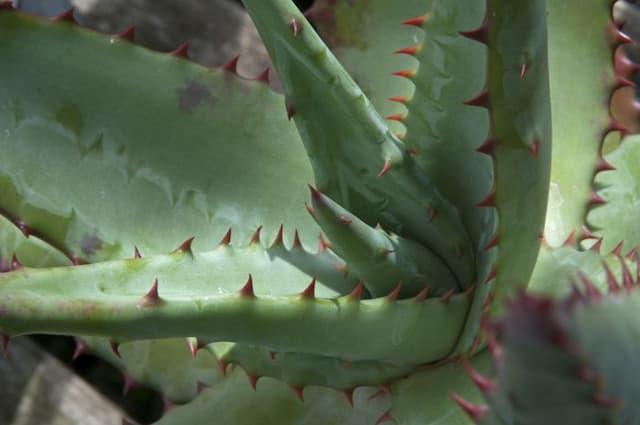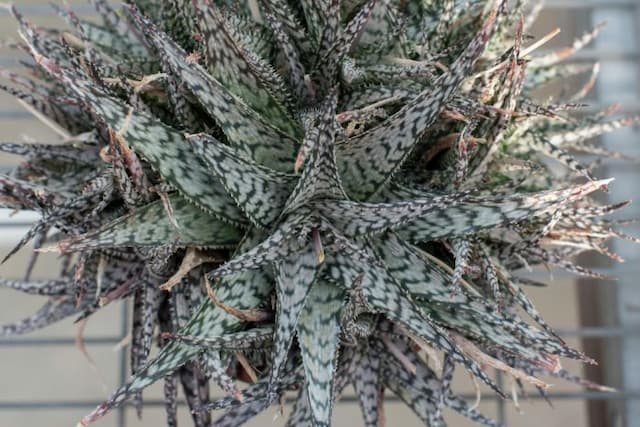Red Hot Poker Kniphofia 'Tetbury Torch' (PBR)

ABOUT
The Kniphofia 'Tetbury Torch' commonly known as Red Hot Poker, has a striking appearance featuring bold, vertical spires of densely packed, tubular flowers. The blooms exhibit a gradient of hues, usually displaying a fiery palette that transitions from a warm, glowing orange at the top down to a rich, deep red at the base. This gradient gives the impression of a flaming torch, which is how the plant got its common name. The blossoms are held high above clumps of slender, arching, grass-like leaves that are a bright green, adding to the lush, upright profile of the plant. The overall effect is of vibrant, eye-catching spikes of color that add a tropical or exotic look to gardens or landscapes.
About this plant
 Names
NamesFamily
Asphodelaceae
Synonyms
Red Hot Poker, Torch Lily, Tritoma
Common names
Kniphofia 'Tetbury Torch' (PBR)
 Toxicity
ToxicityTo humans
Red hot poker plants are not known to be toxic to humans. However, as with many plants, it is possible for individuals to have allergic reactions or skin irritation from handling the plant, especially if they have sensitive skin or a specific allergy. Ingesting parts of the plant is not recommended, as it is not intended for human consumption, but it is not known to contain any toxic compounds that would cause poisoning.
To pets
Red hot poker plants are generally considered non-toxic to pets. However, individual animals might experience gastrointestinal upset, such as vomiting or diarrhea, if they ingest parts of the plant, particularly in large amounts. It is always best to discourage pets from eating plants as a precaution.
 Characteristics
CharacteristicsLife cycle
Perennials
Foliage type
Evergreen
Color of leaves
Green
Flower color
Mixed
Height
3-4 feet (0.9-1.2 meters)
Spread
1-2 feet (0.3-0.6 meters)
Plant type
Herb
Hardiness zones
6
Native area
South Africa
Benefits
 General Benefits
General Benefits- Attracts Pollinators: Kniphofia 'Tetbury Torch', commonly known as Red Hot Poker, is attractive to bees, butterflies and birds, making it an excellent choice for wildlife gardens.
- Drought Tolerant: Once established, it has low water requirements and is suitable for xeriscaping.
- Low Maintenance: It needs minimal care once planted, making it ideal for gardeners with limited time.
- Long Blooming Period: The plant has a long flowering season, providing color in the garden from early to late summer.
- Architectural Interest: Its vertical spikes of flowers add a strong architectural element to garden designs.
- Perennial Lifespan: Being a perennial, it returns year after year, adding enduring value to the garden.
- Versatile Planting Options: It can be used in borders, beds, and as an accent plant due to its striking appearance.
- Color Variety: Produces vibrant, torch-like flowers that can add bright and bold colors to any garden palette.
- Deer Resistant: It is generally resistant to deer, which can be particularly beneficial in areas where deer browsing is a problem.
 Medical Properties
Medical PropertiesThis plant is not used for medical purposes.
 Air-purifying Qualities
Air-purifying QualitiesThis plant is not specifically known for air purifying qualities.
 Other Uses
Other Uses- Red hot poker 'Tetbury Torch' can be used as a natural dye source, with its flowers providing pigments for coloring fabrics and yarn.
- The dried seed heads of the red hot poker can be included in floral arrangements and bouquets, adding a unique texture and shape.
- Its tall flower spikes can serve as natural fencing or borders in a garden to delineate spaces or create visual barriers.
- The leaves of red hot poker can be woven into baskets or used as part of thatching materials in small-scale models or craft projects.
- Red hot poker sap, although rarely used, can sometimes be explored as a natural adhesive component in paper-making or art.
- When planted strategically, red hot pokers can be a part of a garden designed to guide foot traffic, due to their tall and striking presence.
- The striking appearance of red hot poker flowers makes them a popular subject for botanical illustration and photography, inspiring artists and photographers.
- Red hot poker plants can be used in educational environments to teach about pollination and the ecological importance of attracting pollinators.
- In areas where it's appropriate, dried red hot poker plant material can often be used as kindling or in compost heaps to add organic matter to the soil.
- As part of a sensory garden, the textured foliage, and vivid flowers of red hot poker plants provide tactile and visual stimuli for an interactive experience.
Interesting Facts
 Feng Shui
Feng ShuiThe Red Hot Poker is not used in Feng Shui practice.
 Zodiac Sign Compitability
Zodiac Sign CompitabilityThe Red Hot Poker is not used in astrology practice.
 Plant Symbolism
Plant Symbolism- Standout Appearance: Often referred to by its common name, Red Hot Poker, the Kniphofia 'Tetbury Torch' is known for its striking, torch-like flowers that command attention in any garden, symbolizing a presence that cannot be ignored.
- Vibrancy: The bright colors of the Red Hot Poker's blooms range from red to orange and can symbolize vibrancy in life, energy, and enthusiasm, reflecting the plant's spirited and lively nature.
- Attraction: Red Hot Poker is known for attracting hummingbirds and other pollinators, symbolizing attraction and magnetism, as well as the ability to draw in others with one's inherent qualities.
- Strength and Survival: The Red Hot Poker is a hardy plant that can thrive in tough environmental conditions, symbolizing resilience, hardiness, and the ability to withstand challenges.
 Water
WaterRed Hot Poker plants prefer consistent moisture and should be watered regularly, especially during dry spells. Ideal watering for an established Kniphofia 'Tetbury Torch' should be about once a week, providing approximately one inch of water each time. In hotter, drier periods, they may need additional water. Be careful to avoid overwatering, as they do not like to sit in waterlogged soil. It is best to water deeply and infrequently rather than shallow and often, aiming for about 1.5 gallons per square foot every week during the growing season.
 Light
LightThe Red Hot Poker thrives in full sun conditions. It needs at least six hours of direct sunlight every day to perform its best. The ideal spot for planting Kniphofia 'Tetbury Torch' would be a location that receives unfiltered sunlight for most of the day, as this will encourage more vibrant blooms and stronger growth.
 Temperature
TemperatureRed Hot Pokers are relatively tough plants that can tolerate a wide range of temperatures, although the ideal growing temperatures are between 50°F and 75°F. They can survive minimum temperatures down to around 20°F, but should be protected from extreme cold. During the hot summer months, they can handle temperatures up to about 90°F without any major problems.
 Pruning
PruningPruning Red Hot Pokers should be done to remove spent flower stalks and to tidy up the plant's appearance. This can encourage a second flush of blooms. The best time for pruning Kniphofia 'Tetbury Torch' is in late spring or early summer, after the first wave of flowering has finished. Remove only the old flower spikes at their base, and do this perhaps twice a season or as necessary to keep the plant looking neat.
 Cleaning
CleaningAs needed
 Soil
SoilThe Red Hot Poker (common name for Kniphofia 'Tetbury Torch') thrives in soil that is well-draining and rich in organic matter. A mix of two parts loam, one part peat or compost, and one part sharp sand or perlite is suitable. The ideal pH for the soil should range between 6.0 and 6.5 for optimal growth.
 Repotting
RepottingRed Hot Pokers like Kniphofia 'Tetbury Torch' are perennial plants and do not need frequent repotting. They can be repotted or divided every 3 to 5 years in the spring to ensure that they continue to grow vigorously.
 Humidity & Misting
Humidity & MistingRed Hot Pokers, such as the Kniphofia 'Tetbury Torch,' are tolerant of various humidity levels and do not require any special humidity conditions. They are well adapted to outdoor conditions and thrive in a typical garden atmosphere.
 Suitable locations
Suitable locationsIndoor
Place in bright, indirect light and maintain room temperature.
Outdoor
Plant in full sun, protect from harsh winds, well-draining soil.
Hardiness zone
6-9 USDA
 Life cycle
Life cycleKniphofia 'Tetbury Torch', commonly known as Red Hot Poker, begins its life as a seed, which germinates in warm soil with proper moisture. Upon sprouting, the seedling develops a basal rosette of narrow, strap-like leaves and a small root system. As it matures, the plant's foliage expands and its roots grow deeper, preparing for the perennial growth cycle. The distinct flowering stage occurs when tall, upright flower spikes emerge from the center of the rosette, showcasing tubular flowers that transition from fiery red at the top to a warm yellow towards the base. After pollination, often by hummingbirds and bees, the flowers fade and seed pods form, eventually releasing seeds to propagate future generations. During winter or unfavorable conditions, the plant enters a dormancy phase, where above-ground growth ceases, but it remains alive through its hardy roots, ready to regrow in the following season.
 Propogation
PropogationPropogation time
Early summer
The most popular method of propagating Red Hot Poker 'Tetbury Torch' is through division. This is typically done in the springtime when the plant is actively growing. To propagate by division, carefully dig up a mature clump and gently separate it into smaller sections, each with at least one shoot and a portion of the root system. These newly divided sections can then be replanted at the same depth they were originally growing at, spaced approximately 18 inches (about 45 centimeters) apart to allow enough room for growth. After planting, water the divisions thoroughly to help establish them. It's important to maintain consistent moisture while the plants settle and begin to produce new growth.









